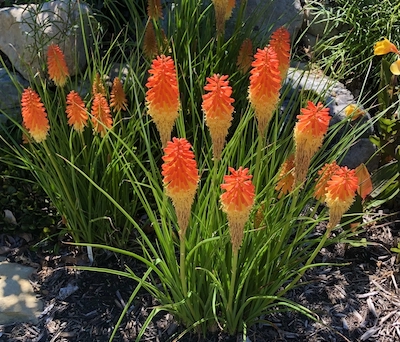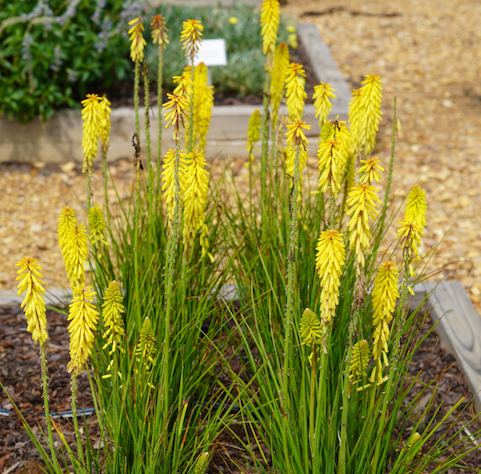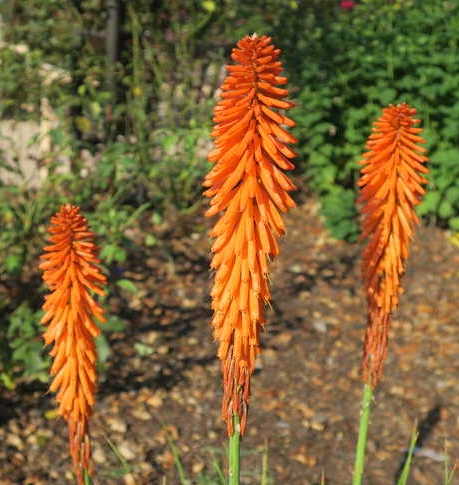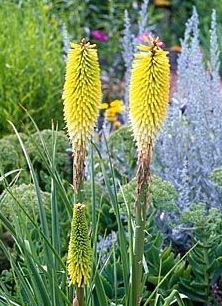Kniphofia: Versatile and Vibrant
by Janet Scheren, Fairfax Master Gardener

Kniphofia ‘Backdraft’
Kniphofia (nip-HOE-fee-uh), commonly known as Red Hot Poker, is a striking perennial that has earned its place in many gardens for its vivid, torch-like flower spikes. Among other attributes, it is extremely resilient and well suited to a variety of growing conditions and garden styles.
It can be used as a vertical element in a mixed border, unifying the design with repetition. Alternatively, it can be installed near a water feature to add drama and contrast or placed in a container as a dramatic focal point. It lends itself to modern landscapes as well as cottage-style borders and butterfly gardens. It can also serve as a mainstay in a tropical-themed garden. Kniphofia provides ecological value as well. It is attractive to hummingbirds, bees and butterflies, and fortunately, not to deer.
While the plant is also known as the torch lily, it is not a true lily. It is a rhizomatous perennial that can be an aggressive grower in favorable conditions. It is even considered invasive in some areas. Native to South Africa, there are 70 species, though most garden varieties are hybrids. The exotic-looking flowers, which resemble glowing pokers or tiki torches, occur during summer and fall in tones of red, orange, yellow, chartreuse and white. The different types can also vary in size, ranging from dwarf to tall.

Kniphofia ‘Glowstick’
This sun-loving perennial is considered easy to grow for beginners and advanced gardeners alike. Kniphofia is tolerant of heat and drought, low maintenance and resistant to most pests and diseases. It thrives in full sun and well-drained soil. Ideal soil conditions include a rich, humusy composition. The main growing constraint is providing adequate drainage, as waterlogged areas can lead to root rot. Additionally, you should also choose a location that offers protection from strong winds to maintain the plant’s upright flower spikes.
Once established, Kniphofia requires minimal maintenance. Dividing the clumps every three to four years helps promote vigorous growth and prevent overcrowding. Regular division also rejuvenates the plant, ensuring that it continues to produce vibrant blooms year after year. Mulching around the base helps to retain moisture and protect roots, especially in colder climates. You will also want to cut plants back to about 3 to 4 inches (7 to 10 cm) above the ground at the start of the growing season before new growth emerges. When flowers begin to fade, simply cut them away from the stem with a sharp pair of garden shears about one-half inch below the flowers.

Kniphofia ‘Rockette Orange”
Kniphofia is most commonly propagated by division. Division should be done every three to four years in the spring, a process that helps rejuvenate the plant and encourages vigorous blooming. Kniphofia grows in clumps, which can reach up to 3 feet (1 m) in diameter. Periodic division prevents overcrowding and helps to maintain plant health.
When dividing Kniphofia, it is best to dig up the entire clump and separate it into smaller sections, each with a good amount of root and shoots. Replant these sections immediately to ensure that the new plants will thrive.
Growing Kniphofia from seed is less common but can be rewarding for those who enjoy the challenge of starting plants from scratch. Seeds should be sown in a well-draining seed mix and kept at a consistent temperature. Germination can take several weeks, and young plants should be protected from frost until they are well established.

Kniphofia ‘Citrina’
Perennial borders
Kniphofia makes an excellent specimen plant, capable of serving as a focal point in the garden. Its bright colors draw attention and create a sense of movement and energy. It is particularly effective when planted en masse. Additionally, Kniphofia works well in naturalistic plantings and can be used to create a bold, exotic look in Mediterranean-style gardens.
Cottage style
Mix Kniphofia with your favorite perennial flowers such as Daisies, Yarrow, Salvia and Lilies.
Butterfly garden
Plant Kniphofia alongside other butterfly-attracting plants such as Lantana, Monarda, Milkweed, Pentas, Salvia and Liatris.
Erosion control and poor-quality soils
Mass along a slope or hillside to help stem erosion. The plant’s hardiness and tolerance of varying soil types also make it a good candidate for other challenging spots in the garden, such as areas with poor soil quality.
Containers
Feature a smaller variety as a stand-alone specimen in a container.
Cutting garden
Include Kniphofia in a cutting garden with Dahlias, Zinnias, Cosmos, Coneflowers, Daisies and Sunflowers.
Tropical-themed border
Create a tropical-themed border using Red Hot Poker plants in combination with other bold, tropical-looking plants such as Bananas, Canna Lilies, Elephant Ears (Colocasia), Lantana, Coleus and Hibiscus. To extend bloom time, plant varieties of Kniphofia that bloom at different times from early summer to mid-fall.
Value to Wildlife
Kniphofia is a magnet for pollinators, which adds an ecological benefit to its ornamental value. Its tubular flowers are rich in nectar, making them a favorite of hummingbirds, bees and butterflies. Thus, incorporating Kniphofia in a garden contributes to the health of pollinator populations, which are essential for the pollination of many food crops and native plants.
-
References
- Kniphofia, North Carolina Extension Gardener Plant Toolbox
- Kniphofia — They’re Red Hot, UC Davis Arboretum and UC Master Gardeners of Napa County
- Red-Hot Poker, Washington State University, Clark County Extension